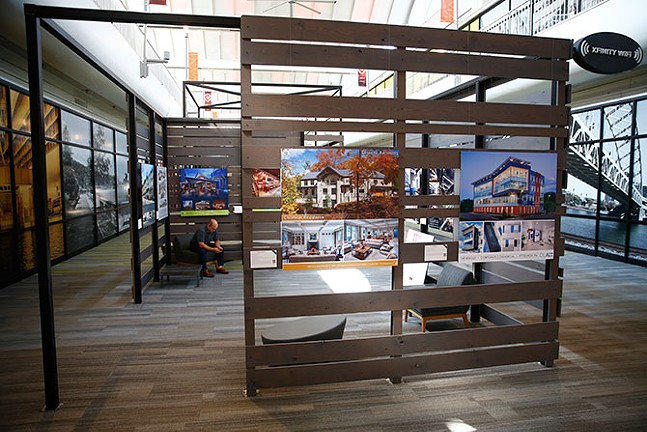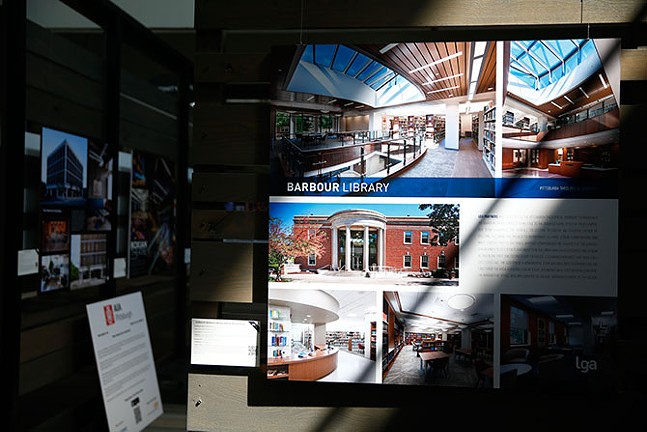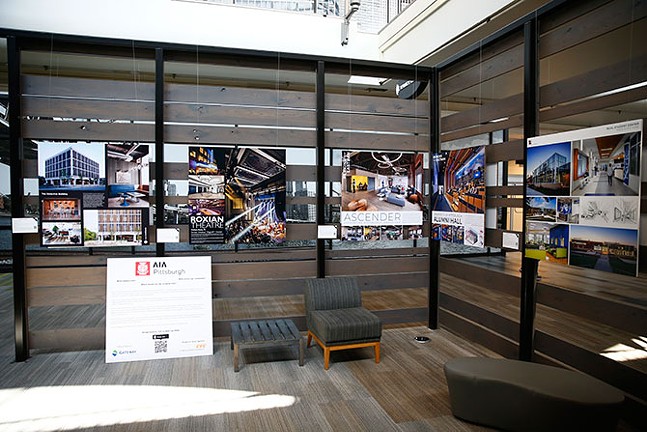What can architecture do for you? That question underlies the new exhibit by the American Institute of Architects (AIA) currently on display in the mall interior portion of Nova Place, where presentation boards illustrate and describe the many projects that member firms have submitted for this year’s Design Pittsburgh Awards. Commercial high-rises, residential blocks, academic buildings, office interiors, city plans, concert halls, and individual houses all vie for attention.
Winners will be recognized in a ceremony at the New Hazlett Theater and a reception in Nova Place on Thu., Oct. 3. Tickets are still available, though the pricey $125 cost for non-AIA members, hints at how this enterprise, even with its People’s Choice award, does not really care for outsiders. (Pro-tip: Go visit the exhibited boards in Nova Place for free.)
Criteria for awards, roughly stated, include concept; detailing and execution; solution of difficult program constraints; design originality; and sustainability. Categories are separated by project size and whether the design is built or unbuilt. Surprisingly, there are no separate categories for historic preservation, interior architecture, or urban planning.
It’s even more surprising that service and community building/rebuilding are not stated more explicitly as criteria. In this regard, the August Wilson House by Pfaffmann + Associates stands out. The project is admirable as historic preservation, turning a threatened and under-utilized property into a theatrical venue, arts center, and community hub. But, further, it is a profound cultural resurgence at a complex crossroads of social justice and creative arts. This project should win the AIA’s top award, the Silver Medal.
Indeed, part of the fun is trying to pick the best projects in advance.
Loysen + Kreuthmeier Architects' Oakland Affordable Living, while austere, is thoughtful and rigorous. Indovina Associates' 2554 Smallman Street condo project, at the other end of the design spectrum, is a little bit overzealous, but it displays some real architectural thinking in space and materials while reflecting better impulses from broader design culture.
Both Eric Fisher and Andrew Moss have submitted admirable contemporary single-family house designs — a building type where the architect’s artistic capacities can be on especially conspicuous display.
PWWG Architects’ Roxian Theatre and Margittai Architects’ Kingfly Spirits both revive historic structures of contrasting varieties, using significant alterations that manage to accommodate new uses and new code requirements while preserving and enhancing period charm. The limited format of the presentation boards doesn’t allow the full transformational nature of these (or really any) projects to come through fully, but they are still great achievements.
Honestly, though, it would be at least as instructive to pick the worst projects, whether in the awards or just in the city itself. It’s nice that we have bits of good design, but in today’s Pittsburgh, bad design is more widespread. And if we don’t speak up, we are on track to get more.
Strada Architecture is an underwriter of the awards, but its proposal for the multi-use grocery store apartment complex on the Shakespeare Giant Eagle is exactly the kind of ill-conceived, watered-down architecture that has been the subject of national criticism in publications including Bloomberg News and Curbed.com. (The complexities of parking, traffic, landscape, and affordability are crucial components in a longer discussion.)
Why are the designers proposing a kind of building that has been discredited nationally when better design approaches are available? Why does the profession praise its achievers, but not self-police its laggards, hacks, and profiteers? No one goes to a restaurant run by nice people if it has bad food. Why should architecture be any different?
Every architect has an education that includes studio reviews and critiques in which outside experts study their design and submit criticisms, often harshly, during the process to improve the work. For some reason, this falls by the wayside in much professional practice. City Planning and the Contextual Design Advisory Panel do some of this work, but they are not sufficiently emphatic, visible, or binding.
The AIA should resuscitate and promote such outside critiques of architecture, not just to praise the achievers, but to bring the bad actors back in line. This is something that architecture needs to do for itself before it can accomplish anything for the rest of us.


















